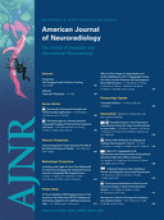Abstract
BACKGROUND AND PURPOSE: There is wide discrepancy between common clinical and radiologic presentations of branchial sinuses arising from the pyriform fossa and the theoretic course of third and fourth branchial arch anomalies. The purpose of this study was to revisit the clinical presentations and imaging features of such anomalies in children.
MATERIALS AND METHODS: A retrospective review of institutional and diagnostic imaging data bases from 1998 to 2008 for reported cases of third and fourth branchial cleft anomalies was conducted. Clinical presentation, pharyngoscopy results, and imaging features in all the patients were evaluated. Surgical and histopathology correlation in patients who underwent excision of the tract was also obtained.
RESULTS: Twenty reported cases described as third or fourth branchial apparatus anomalies were identified. There were 12 females and 8 males with a mean age of 84.6 months. The most common presentation was an inflammatory neck mass (18/20, 90%) almost always involving the thyroid gland. Most lesions were on the left side (16/20, 80%). Pharyngoscopy showed a sinus opening at the piriform fossa in 18/20 (90%) cases. None of the cases followed the classic theoretic pathway of third and fourth arch remnants. Histopathology showed tracts lined with pseudostratified squamous epithelium or ciliated columnar epithelium often associated with inflammatory changes in 17 surgically resected cases.
CONCLUSIONS: Branchial sinuses arising from the pyriform fossa often present with an inflammatory neck mass involving the thyroid lobe, most often on the left side. Imaging and surgical findings suggest that they arise from the embryonal thymopharyngeal duct of the third branchial pouch, because they do not follow the hypothetic course of third or fourth arch fistulas.
Abbreviations
- Adj
- adjacent
- E
- epiglottis
- H
- hyoid bone
- Infl neck mass
- inflammatory neck mass
- L
- left side
- MRI
- MR imaging
- Noninfl
- noninflammatory
- Piriform S
- piriform sinus opening
- R
- right side
- SI
- signal intensity
- TC
- thyroid cartilage
- TG
- thyroid gland
- Thyroid Inv
- thyroid gland involvement
- US
- ultrasonography
- Copyright © American Society of Neuroradiology












